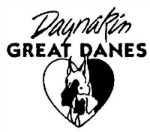- Home Page
- About Us
- Welcome To My Site
- Before you Buy a Dane
- Puppies and Adults
- Boarding
- Classes & Seminars
- Dane Care/Training
- Adaptable
- Crates-A Necessity
- Cropped Ear Info
- Danes and Children
- Frequent Questions
- General Training Info
- Grooming
- Helpful Vet Supplies
- If You Die......
- Living With Old Danes
- Puppy Care
- Show Training Your Dane
- Socialization
- Space Etiquette for Dogs
- Stressed Dog Management
- Temperament
- Two Puppies Together?
- Vet Med
- Home Page
- Dog Show Handling
- Great Dane Information
- Guestbook
- Items For Sale
- Our Dogs
- Sitemap
- Tips
- Search This Site
- Logan
- Tayo
- Stud Dogs
- Leo
- Medical Devices
- Fact & Fallacy
- Pet Transport
Daynakin Great Danes LLC
Est. 1974
Championship Quality AKC Fawn & Brindle Great Danes
For Show, Performance and Companionship

Frequent Questions
Help! My dog isn’t eating!
If you are asking this question, chances are pretty good that you have an adolescent male Great Dane. It seems when many males go through this “teenage” stage, they go off their food. Hormones could be keeping them more interested in other stuff, or just part of Dane development, it’s a pretty common concern among owners. Some owners are worried because their dog is too thin for the show ring; others simply that their dog doesn’t look like he’s being cared for. The good news is this generally is a stage, and the dog will outgrow it as long as you do not fall into the “what can we add today to get the dog to eat” trap.
The first step is to determine nothing is medically wrong with the dog. A very careful mouth exam will rule out a sore tooth, something stuck in the mouth, or tonsillitis. (Note that many vets unfamiliar with Danes do not recognize Danes can develop this problem. They do, and while many do not exhibit obvious signs, it makes their throat sore and they will stop eating.) Is something else bothering the dog? And of course it goes without saying that a male living with a bitch in season in the same household isn’t going to eat!
The owner has a few choices. They can continue to add new stuff to the food (and teach the dog to hold out for even better additions), they can force feed the dog, or they can teach the dog to eat.
Adding different things or changing the type of food rarely works long term. The dog might eat for a short while but then will soon tire of it, and then the human had to add more stuff to make it interesting, the dog tires of that, and the cycle goes on.
Force feeding it really not an acceptable long-term solution and once started, most likely will need to be continued throughout the dog’s show career.
Teaching the dog to eat is the best bet. No healthy dog will starve himself to death. Of course, in the process the person who exhibits might have to forgo some shows, as the dog will drop more weight during this “training period”.
Generally, teaching a dog to eat consists of:
- First, feed a calorie-dense food. Your dog will not need to eat as much to gain or maintain weight. (Be sure to check protein and fat percentages if you are feeding a Dane still in the growing stages.)
- Have set mealtimes and try to be consistent.
- When you start this, give the regular evening meal. The next day, do NOT offer the dog ANY food. No treats, no nothing. I know this is hard to do, but remember if the dog hasn’t been eating, he probably wouldn’t anyhow.
- The next morning, offer 1 cup of his food. Give him 10 minutes to eat it. If he does not, immediately take it away and do not give anything else until dinner. Ditto if he does eat it; you want the dog to learn there is NOT a never-ending quantity of food available.
- Repeat the same at dinner; offer 1 cup of food and give 10 minutes to eat. If he does not eat, no breakfast the next morning.
- If you have another dog, feed that dog the food he has refused and let him see that dog eating it.
- Usually, within a day or two, most dogs start eating and at that point, gradually increase the quantity until you get to the normal ration.
This may seem harsh, and even doing this may not work for every dog. Some Danes just have a leaner body-type and just aren’t big eaters. Just like all people are individuals in their eating habits, dogs can be the same way.
Interestingly, some people feel that the tendency towards not eat is hereditary. For me, the jury is out on that one. I think teaching good eating habits as a youngster, and following through with them during the teenage stage, can be very helpful in teaching the dog to eat his meals. However, there simply are going to be some Danes that do not eat well, and the owner who shows will need to decide if they are simply going to hold the dog out of the ring until the dog is past that stage, or resort to other means.
And, for those reading this that have other breeds: Danes not eating is a very common problem. If a Ridgeback or a Lab quit eating, that would be cause for a vet trip. However, with a Dane, it’s pretty much a stage. Usually once these dogs are over three years of age they have the opposite problem—being too fat!
Georgia Hymmen
© 2014
Permission to reprint as long as credit is given to author and printed in its entirety
